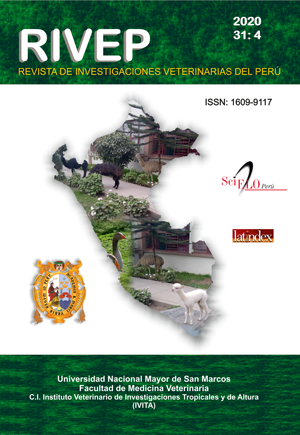Variation in fibre diameter due to the effect of medullation in fine fleeces of Huacaya alpacas of three age groups
DOI:
https://doi.org/10.15381/rivep.v31i4.19026Keywords:
alpaca, fibre, medullation, diameter, ageAbstract
The aim of this study was to evaluate the effect of the medullation and age on the variation of the diameter of fine fleece fibres. In total, 24 703 fibres were obtained from the flank of 186 female Huacaya alpacas, white colour, 1.5-2 years old (two teeth), 3-4 years old (four teeth) and more than 4 years old (full mouth) were evaluated. The fibres were categorized according to their diameter as extra-fine, fine, medium-fine and thick, and according to the medulla as complete, split and without medulla. The average diameter of the fibres within each category and type of medulla was similar between the different age groups. The simple effect between the categories of the fibres and the types of medullation resulted in a significant dependence (p<0.01), where the diameter of the fibre increases due to the presence of medullation (split and complete) and decreases in its absence. It is concluded that medullation causes variation in the diameter of the fibres, and the presence of fibres with split medullation is the intermediate step in decreasing the diameter and frequency of medullated fibres. On the other hand, the absence of the effect of age associated with the environmental effect of the number of shearing in the oldest alpacas suggests the expression of a genetic potential that could be used in genetic improvement programs.
Downloads
Downloads
Published
Issue
Section
License
Copyright (c) 2020 Ana Luz Guillén P., Víctor Leyva V.

This work is licensed under a Creative Commons Attribution-NonCommercial-ShareAlike 4.0 International License.
AUTHORS RETAIN THEIR RIGHTS:
a. Authors retain their trade mark rights and patent, and also on any process or procedure described in the article.
b. Authors retain their right to share, copy, distribute, perform and publicly communicate their article (eg, to place their article in an institutional repository or publish it in a book), with an acknowledgment of its initial publication in the Revista de Investigaciones Veterinarias del Perú (RIVEP).
c. Authors retain theirs right to make a subsequent publication of their work, to use the article or any part thereof (eg a compilation of his papers, lecture notes, thesis, or a book), always indicating the source of publication (the originator of the work, journal, volume, number and date).



